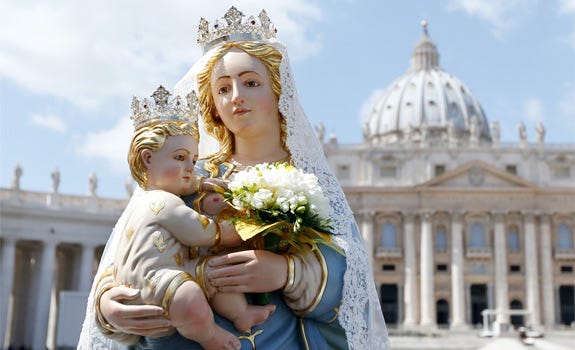The Vatican Document on Mary
Nothing Has Changed in Mary's Role in the Church
Some years ago, when I was still an anti-Catholic Protestant, titles such as Co-Redemptrix and Mediatrix of All Grace would have provoked tremendous outrage. They seemed to me then like a violation of the uniqueness of Christ’s redemptive work. For many Protestants, these expressions appear to blur the line between worship owed to God alone and the honor due to saints. With time, through a more disciplined study of Scripture and the writings of the Fathers, I came to understand that the Catholic use of these titles is theological shorthand for Mary’s subordinate and participatory role in the work of redemption. Even so, I recognize that such terminology can create obstacles for Christian unity. The new document from the Dicastery for the Doctrine of the Faith, Mater Populi Fidelis, addresses these same concerns. Its release on November 4, 2025, reaffirms devotion to the Blessed Virgin while clarifying its doctrinal boundaries.
The document opens by recalling that “The Mother of the Faithful People of God is viewed with affection and admiration by Christians because, since grace makes us like Christ, Mary is the most perfect expression of Christ’s action that transforms our humanity.” The tone is pastoral rather than apologetic. The Dicastery states that titles such as Mediatrix, Mediatrix of All Graces, Co-Redemptrix, and Redemptrix have appeared frequently in popular devotion, in petitions for new dogmas, and even in online movements. The concern arises when these titles are used without precision. The document observes that such expressions “often sow confusion among ordinary members of the faithful” when they circulate without a theological context. The aim of Mater Populi Fidelis is to accompany and sustain Marian devotion within an authentic Christological and ecclesial framework, especially considering the post-Christian impoverished catechetical grounding of our day.
The Dicastery identifies the fundamental question: “What is the meaning of Mary’s unique cooperation in the plan of salvation?” The Church has long taught that Mary’s “yes” at the Annunciation and her steadfast presence at Calvary represent a singular participation in Christ’s saving work. The title Mediatrix developed in theology to express her maternal intercession for the faithful. The title Co-Redemptrix was used to describe her intimate union with the Redeemer, particularly her participation in his suffering for the salvation of souls. Saint Augustine referred to her as “cooperator in Christ’s Redemption,” underscoring both her cooperation and her subordination to him. The DDF acknowledges these historical and devotional roots, recognizing that they arise from legitimate reflection on Scripture and the Church’s liturgical life.
However, the document draws a doctrinal distinction. It states clearly that “Given the need to explain Mary’s subordinate role to Christ in the work of Redemption, it is always inappropriate to use the title ‘Co-Redemptrix’ to describe Mary’s role. This title risks obscuring the unique salvific mediation of Christ and can therefore generate confusion and imbalance in the harmony of the truths of the Christian faith. When an expression requires many repeated explanations to prevent it from straying from its correct meaning, it does not serve the faith of the People of God and becomes inappropriate.” The emphasis here is on clarity. Words that continually require complex qualification are pastorally ineffective. In the case of Co-Redemptrix, the potential for misunderstanding outweighs its theological precision.
Regarding Mediatrix, the Dicastery exercises a more measured caution. It reminds readers that “strictly speaking, we cannot talk of any other mediation in grace apart from that of the incarnate Son of God.” When the term Mediatrix is used in a way that excludes or overshadows Christ’s unique mediatorship, it becomes theologically unacceptable. Used properly, however, it remains a legitimate way to speak of Mary’s maternal intercession within the communion of saints. Mater Populi Fidelis thus differentiates between private devotional usage and dogmatic expression. The faithful may invoke Mary as Mediatrix in prayerful language, provided they understand that she mediates only through Christ and never apart from him.
Perhaps the most important attitude we can have is to remember that the intent of the document is constructive. It states, “Rather than proposing limits, the present Note seeks to accompany and sustain the love of Mary and trust in her maternal intercession.” The Dicastery affirms the vitality of Marian devotion and asks theologians to ensure that teaching about Mary always reflects her dependence upon Christ. This approach aligns with the Catechism’s statement that “Mary’s function as mother of men in no way obscures or diminishes this unique mediation of Christ, but rather shows its power” (CCC 970). Mater Populi Fidelis reinforces that same truth: Mary magnifies the Lord; she does not replace him. Her dignity flows entirely from the grace of her Son.
From a theological perspective, the way to understand Mary’s participation in salvation is through the principle of instrumental causality. God alone is the first and prime efficient cause of redemption. Yet he chooses to act through created instruments. The prophets were instruments of revelation. The apostles were instruments of the Church’s foundation. We are instruments of sanctification. In a providential way, Mary was the unique instrument through whom the Word took flesh. She cooperated freely with the divine plan, bearing the Redeemer and uniting her sufferings to his. In this subordinate and instrumental sense, she participates in his redemptive mission. The difficulty arises when such participation is described with insufficient nuance and clarity, leading to the false impression that Mary possesses an independent salvific role. This is a truth that needs to be acknowledged: that many well meaning Catholics can inadvertently veer into Mariolatry if not careful.
The Vatican’s concern is, therefore, rooted in pastoral reality. The majority of Catholics do not read Scripture consistently, do not study Church documents, including those of the Second Vatican Council, and often form opinions from media headlines and online commentary. I was recently in a conversation where it became abundantly clear that the topic of conversation, while clearly addressed by the Second Vatican Council, was being debated precisely because Catholics simply haven’t read the council documents. This is just one example. Doctrinal imprecision spreads easily in that environment. Developing a personal magisterium is a temptation all too enticing. The Dicastery’s prudence is therefore warranted. Its task is to teach and guard the faith against distortion. For some, the statement will feel like a restriction. For others, it may seem like a correction long overdue. Yet the real purpose is neither suppression nor novelty. It is the preservation of sound doctrine for the sake of clarity for the faithful. Emotions, preferences, and private opinions must yield to the Church’s magisterial guidance.
There will be those who feel disappointment or frustration. Such reactions are understandable, especially among those deeply devoted to Mary in these titles. Yet this is a moment to exercise intellectual humility and ecclesial obedience. The faith of the Church is not a matter of sentiment or political opinion but of assent to revealed truth. Each believer must learn to bring personal interpretation to the foot of the Cross and allow it to be judged by the wisdom of the magisterium. That discipline safeguards the unity of the Church and ensures that devotion never becomes detached from doctrine.
This clarification also carries ecumenical implications. Many Christians outside the Catholic Church already struggle to understand Marian dogmas such as the Immaculate Conception and the Assumption. Introducing titles like Co-Redemptrix without careful catechesis risks deepening suspicion and reinforcing old divisions. The DDF’s decision, therefore, serves the broader goal of Christian unity. It demonstrates that the Catholic Church remains firmly Christocentric and that Marian devotion, when properly understood, enhances rather than diminishes the centrality of the Savior.
In truth, nothing in this document alters Mary’s dignity or her mission. She remains the Immaculate Mother of God, full of grace, intercessor for the Church, and queen who reigns beside her Son. The Church continues to venerate her as the highest of creatures and the perfect model of faith. The teaching of Mater Populi Fidelis simply urges precision in language and depth in understanding. Devotion to Mary must never drift into sentimentality detached from theology. Love for her must always lead to love for Christ.
For those of us who once viewed Marian doctrines as errors, this statement offers a bridge toward comprehension. It invites deeper reflection on how grace works through created instruments and how divine wisdom exalts humility. Mary’s glory lies in her complete surrender to God’s will. She is the mirror of the Church and the first disciple of her Son. Her cooperation with redemption manifests the truth that human freedom, when united to divine grace, can bear fruit for the salvation of the world.
Mater Populi Fidelis, therefore, deserves to be received with gratitude and calm. It is a call to clarity, obedience, and renewed devotion. Mary’s role in salvation history remains unchanged, even as the Church refines how she speaks about it. Our understanding of that mystery will continue to deepen until the day when faith gives way to sight. Then we will behold, without confusion, the full harmony of the Redeemer and his Mother. Until that day, we can pray with confidence and simplicity: Blessed Virgin Mary, full of grace, Queen of Heaven, intercede for us, that we may love your Son as you loved him and serve him with the same undivided heart.







